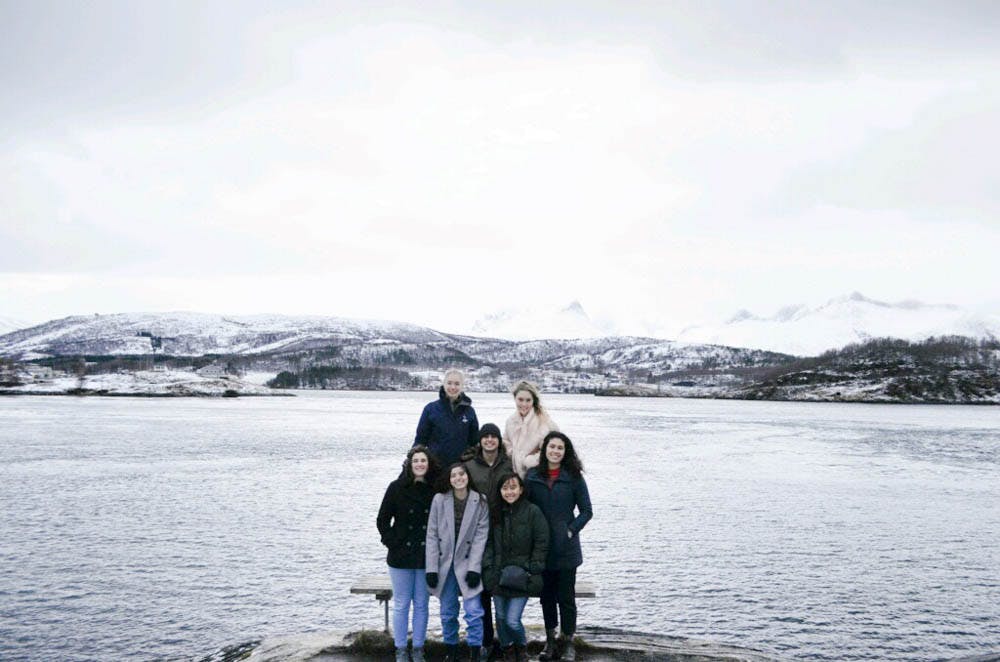For the first time ever this Wintersession, a group of University students traveled to Norway for a course entitled ENVS 1225: “Arctic Climate and Policy” that studies how science, policy and economics will shape the future of the Arctic. University students joined students from Babson College and Nord University Business School, which is located just outside of Bodø, Norway.
The course enrolled a total of 18 students — six from each school — who were accompanied by Professor of Finance and Applied Investments Michael Goldstein of Babson College, Professor of Environmental Studies and Earth, Environmental and Planetary Sciences Amanda Lynch and undergraduate Teaching Assistant Vida Steiro ’20. Students engaged in an immersive learning experience that allowed them to directly interact with the climate they studied while completing nightly readings and interdisciplinary group work for the course.
Once in Norway, students spent the majority of their 16-day trip on the Nord University campus in Bodø — a town located just north of the Arctic Circle. Daylight was limited to between two and four hours each day during their visit. From Bodø, the class crossed the Arctic Ocean by ferry to spend one weekend in Svolvær, a city located on the northern coast of Norway, Steiro said.
In Svolvær, students visited the Norweigian Red Cross Search and Rescue Corps, a volunteer organization that provides disaster relief and rescue support for boats lost in the Arctic Circle. The students’ ferry ride gave them a first-hand understanding of the organization’s importance. “Being on a boat in the Arctic Circle in January in the dark really (puts) things into perspective,” Goldstein said, emphasizing that these conditions make traversing the Arctic Ocean dangerous.
Back in Bodø, students spent time in class and visited local environmental organizations, said Olivia Howe ’22, a class participant. While visiting these organizations, students talked to “professionals who were dealing with the consequences of climate change (and) weren’t very political about it. At Brown, I’m used to people getting really feisty about (climate change) and sometimes they get emotional beyond the point of making sense,” Howe said.
Between class time, nightly reading, the creation of group presentations, lectures from visiting speakers and scientists, data collection and the occasional hike, students came away with firsthand experience and an enhanced understanding of the Arctic overall. “They got temperature and environmental data. They got to learn about how these had changed over time. They got awareness of how complex the Arctic is and how much it is changing” Goldstein said.
During the trip, Howe “learned that even if we stopped burning fossil fuels today, we can be pretty confident that degradation is going to continue.”
“It made me realize it is important to adapt ... trade and that we face economic as well as environmental trade-offs moving forward,” she added.
What made the course “especially unique,” Goldstein explained, was students “learning and working in a community with people they had just met, with backgrounds different from their own — sometimes even speaking different languages.”
The Nord students faced a language barrier when interacting with students from the University and Babson, Lynch said. Five of the students are Norweigan and one is Pakistani, she added. In her role as a teaching assistant, Steiro, who is from Norway herself, helped Nord students “navigate the language barrier and American ways of teaching and learning,” while also providing “cultural guidance for the American and international students.”
Additionally, because Babson is a business school, “Babson students were very economy-focused” said Michelle Motley ’22, a University student who participated in the class.
This interdisciplinary aspect and the conversations sparked from students from different backgrounds were intrinsic to the design of the course, Lynch said. In selecting students for the course, “I tried to select the class that had balance in disciplines, ages, genders and backgrounds, … that was diverse but also well prepared for pretty intensive work,” she said. “A large part of the class was for them to learn from each other across cultures and disciplines.”
The application for the course included an essay outlining why they were interested in the class and describing both past coursework related to climate change and their history with experiential learning, Howe said.
The course itself was intended to be “cost neutral for the students,” Lynch said. “We supported everying we could in terms of travel and food expenses,” with funding from the Institute at Brown for Environment & Soceity and a combination of grants. “The exception was that students had to pay Wintersession tuition, which is something I would like to change in the future,” she added. She said her ultimate goal is “for the course to present no financial barrier.”
At the end of the course, students applied their learnings to specific Arctic countries, about which they made group presentations. The three-person groups consisted of one student from each university.
Both Goldstein and Lynch were impressed with the final presentations, which took a lot of work, Goldstein said. “It was like (the students) were consultants: They had to do a little work each day, put it together, analyze it … I learned a lot, but mostly from them. They did an amazing job. I think they should have a huge amount of pride.”
“The final presentations blew me away,” Lynch added. “They were so well thought out and beautifully insightful.”
When it comes to future plans, Lynch is optimistic about holding the course next year, with improvements based on student feedback. “I think I can certainly recommend it,” she said. “The students got so much out of it — from the course and from each other.”





